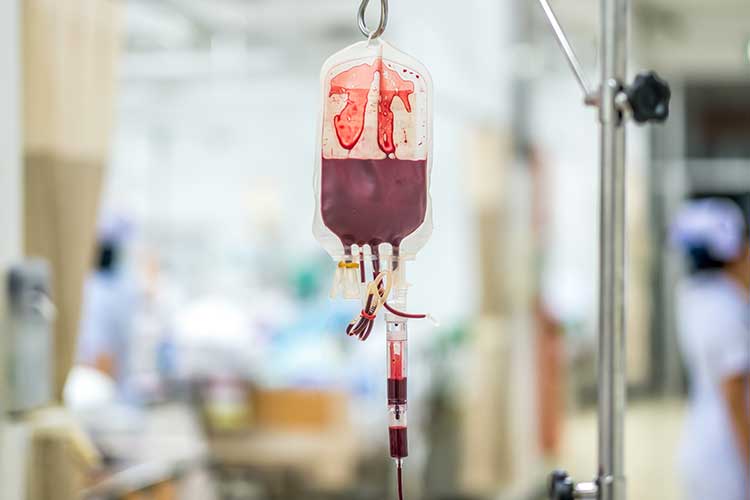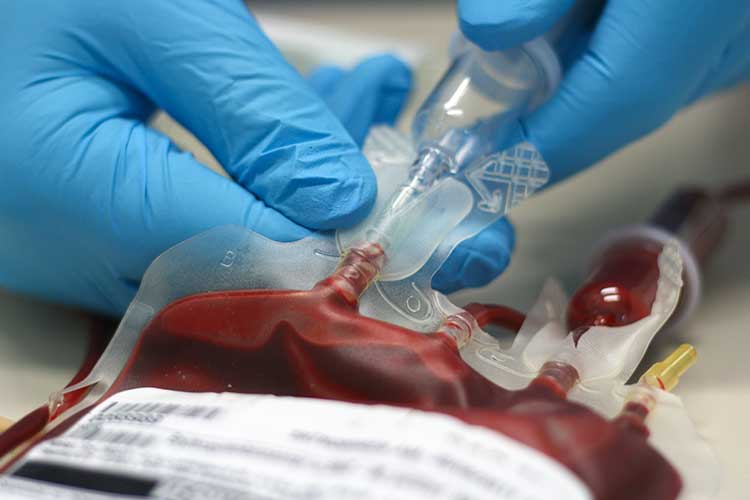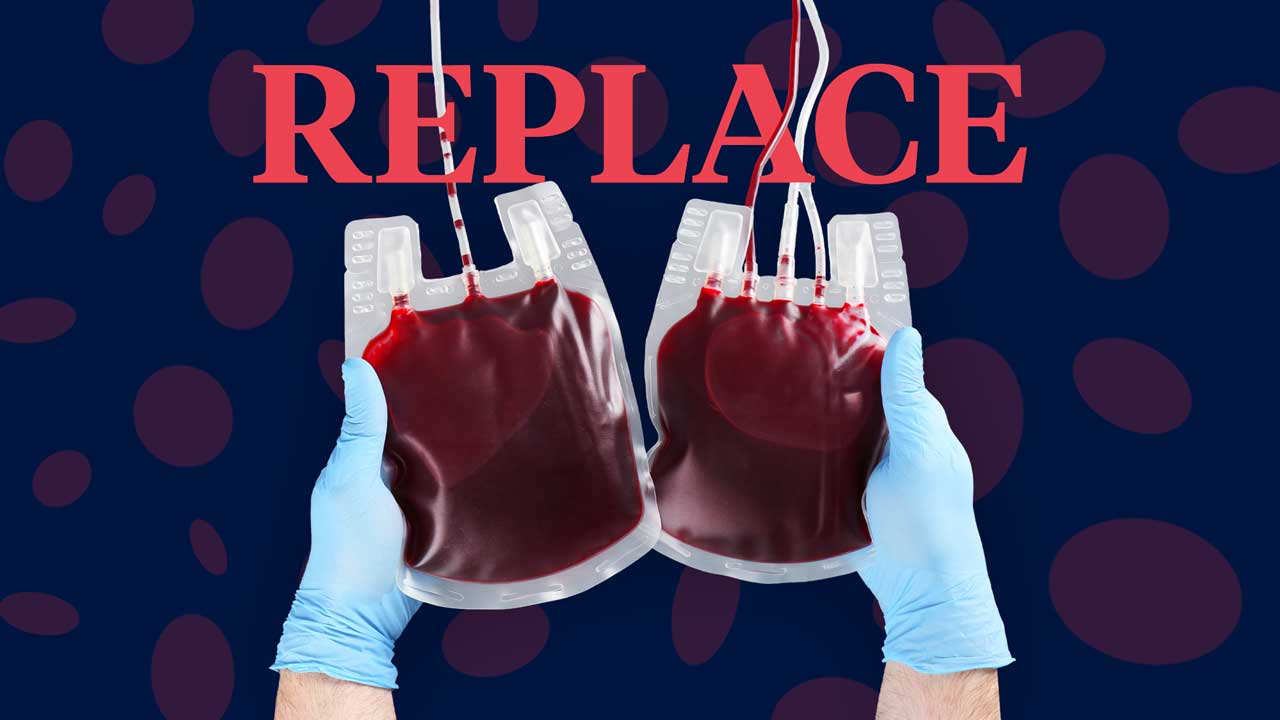What do you need to remember during a massive blood transfusion?
At first glance, this seems like an obvious answer: Give blood! However, the amount of blood that a person receives during a massive blood transfusion can cause complications that need to be addressed concurrently.
To remember the principles involved with managing a patient requiring a massive blood transfusion, remember the acronym ’REPLACE’:
| R | Replace volume |
| E | Exsanguination cessation |
| P | Permissive hypotension |
| L | Low temperature management |
| A | Acidosis management |
| C | Coagulopathy management |
| E | Electrolyte management |
What is a Massive Blood Transfusion?
A massive blood transfusion in an adult can be defined as follows:
- The transfusion of more than one blood volume within 24 hours
- The transfusion of > 50% of an adult’s blood volume within 4 hours.
(Lifeblood 2021)
The average blood volume for adults of ideal body weight is approximately 65-70 mL/kg (RCHM n.d.).
Causes of Massive Haemorrhage Requiring Transfusion
Massive blood transfusions are required in cases of severe haemorrhage such as trauma, ruptured aortic aneurysm, surgery and pregnancy complications (Lifeblood 2025).
Principles of Massive Blood Transfusion

General Principles
The goals of managing major haemorrhage are to:
- Recognise blood loss early
- Control bleeding temporarily (e.g. using compression, packing, tourniquet, pelvic binder)
- Maintain tissue perfusion and oxygenation by restoring blood volume and haemoglobin
- Stop bleeding, including through early surgical or radiological intervention
- Manage coagulopathy through the appropriate use of blood component therapy.
(Lifeblood 2025)
Practical Management Tips
- Establish wide bore intravenous access early
- Ensure adequate access to pre-warmed fluids to maximise the restoration of circulating volume
- Maintain close communication with key personnel, including blood bank, haematology and surgical teams
- Good communication between the treating team and pathology will be required for regular laboratory investigations, including a full set of bloods, to prevent delays.
(Nickson 2023)
REPLACE
Replacement of Intravascular Volume Loss
Excessive bleeding causes a loss of intravascular volume and circulating haemoglobin, resulting in decreased perfusion of the vital organs. This eventually leads to hypovolaemic shock (Taghavi et al. 2025).
The general rule of thumb is that intravascular volume should be replaced by what has been lost. In a bleeding patient, we should replace with blood, if clinically indicated.
If synthetic colloids are used, limit them to a maximum of 1.5 L in 24 hours (Nickson 2023).
Exsanguination Cessation
Attempting to replace the blood that is being lost is futile if the bleeding is not stopped. Contact key personnel such as the blood bank, interventional radiology or the surgical team as soon as possible (Nickson 2023).
If the bleeding is internal, urgent surgical intervention is needed to find and control it. If the source of bleeding is identified, surgical intervention should be the priority alongside blood replacement (ANZCOR 2021; NBA 2024).
Permissive Hypotension
Read: Permissive Hypotension for Trauma Below the Neck
Permissive hypotension is a non-aggressive fluid resuscitation technique in which the patient is intentionally under-resuscitated to keep their blood pressure lower than normal physiologic levels. This aims to ensure blood pressure is low enough to prevent exsanguination but high enough to maintain perfusion (Das et al. 2024; Nickson 2020).
Low Body Temperature Management
Hypothermic people have a slower heart rate, decreased myocardial contractility, and impaired oxygen uptake by the cells, leading to worsening shock. It’s easier to keep a patient warm than to try to warm them up. Use a blood warmer to administer the blood where possible, and remember to put an active warming blanket on the person, aiming for a temperature of ≥ 35°C (NBA 2024).
Acidosis Management
Each unit of blood contains hydrogen ions. As the kidneys can only eliminate a certain amount of hydrogen ions per day, acidosis can occur with massive blood transfusions if the kidneys are unable to keep up with the buffering and removal (Silva & Mohebbi 2022).
While the aim during a massive blood transfusion is to maintain a pH of > 7.2, the metabolic acidosis will eventually rectify itself once the bleeding has been controlled (NBA 2024).
Coagulopathy Management

There are various blood products and adjuncts that can be administered to help slow the bleeding, including:
- Fresh Frozen Plasma (FFP) that contains all the coagulation factors in normal concentrations and promotes coagulation of blood along the intrinsic, extrinsic and common pathways.
- Platelets, which help to form a stabilised clot by binding with fibrin fibres.
- Cryoprecipitate that contains mostly fibrinogen, factor 8, factor 13 and von Willebrand factor - administer 3 to 4 grams if the fibrinogen is less than 1.0 g/L.
- Tranexamic acid (TXA), which is an antifibrinolytic that works to counteract the degrading effects that plasmin has on fibrin, thereby preserving stabilised fibrin to participate in the clotting process for longer. The recommendation is a loading dose of 1 gram over 10 minutes, followed by an infusion of 1 gram over the next 8 hours.
- Protamine, which helps reverse the effects of heparin if the bleeding is thought to be a result of a heparin-induced coagulopathy.
- Vitamin K, which helps to activate factors 2, 7, 9 and 10 if the bleeding is thought to be a result of a warfarin-induced coagulopathy.
(NBA 2024; Nickson 2023)
Electrolyte Derangement Management
Each unit of blood contains citrate, which prevents blood clotting by binding to ionised calcium, significantly impeding the clotting cascade. The liver converts citrate to bicarbonate, thereby releasing calcium ions to facilitate the blood's clotting ability. However, a massive blood transfusion overwhelms this process.
For this reason, calcium needs to be replaced to maintain an ionised calcium level of more than 1.0 mmol/L (NBA 2024).
Massive Transfusion Protocols
Some patients will require the activation of a massive transfusion protocol. This may vary per facility and protocol, but it is usually when at least five units of packed red blood cells (PRBC) are required within four hours. The frequency and type of monitoring of blood results will also be stipulated in a massive transfusion protocol (Farkas 2021; Lifeblood 2025).
A major haemorrhage protocol template is available here on the National Blood Authority’s website.
Complications Associated with Management of Massive Blood Loss
Safe transfusion practice and appropriate patient monitoring are essential in avoiding complications and addressing any transfusion reactions.
The management of massive blood loss itself also has a variety of potential complications, including:
- Disseminated intravascular coagulopathy (DIC)
- Fluid over/underload
- Electrolyte and metabolic disturbance, including hyperkalaemia and hypokalaemia
- Citrate-toxicity
- Hypothermia
- Immediate generalised reactions, e.g. transfusion-related lung injury (TRALI), anaphylaxis
- Delayed transfusion reaction
- Transmission of infections.
(Nickson 2023)
Patient Blood Management
No discussion of blood transfusion should take place without an adequate understanding of patient blood management (PBM).
PBM is based on the view that ‘the best and safest blood for most patients is their own circulating blood’ (ACSQHC 2025).
The three principles of PBM are to:
- Optimise the patient’s own blood by identifying factors that might lead to a blood transfusion
- Minimise blood loss
- Optimise tolerance of anaemia without resorting to a blood transfusion (if possible).
(ACSQHC 2025)
For more information on PBM, see the Blood Management NSQHS Standard.
Read: National Safety and Quality Health Service Standards (NSQHSS) Explained
Cell Salvage Programs
One method of reducing exposure to blood that is not the patient’s is through cell salvage, a process that involves collecting, processing and re-infusing the patient’s own red blood cells. This not only reduces the risk of transfusion reactions but also decreases the risk of the patient receiving the wrong blood due to errors (NBA 2014).
Cell salvage is part of good patient blood management.
Conclusion

There are numerous considerations that need to be taken during a massive blood transfusion in order to prevent adverse outcomes for the patient.
The acronym REPLACE can be used to remember these key management principles. Additionally, good communication and maintaining safe transfusion practices and patient blood management principles are essential.
Test Your Knowledge
Question 1 of 3
Which one of the following is a principle of patient blood management?
Topics
Further your knowledge
 Free
Free Free
Free Free
FreeReferences
- Australian Commission on Safety and Quality in Healthcare 2025, Blood Management Standard, Australian Government, viewed 22 August 2025, https://www.safetyandquality.gov.au/standards/nsqhs-standards/blood-management-standard
- Australian and New Zealand Committee on Resuscitation 2021, ANZCOR Guideline 9.1.1 – First Aid for Management of Bleeding, ANZCOR, 22 August 2025, https://www.anzcor.org/home/first-aid-management-of-injuries/guideline-9-1-1-first-aid-for-management-of-bleeding
- Das, JM, Anosike, K & Waseem, M 2024, ‘Permissive Hypotension’, StatPearls, viewed 22 August 2025, https://www.ncbi.nlm.nih.gov/books/NBK558915/
- Farkas, J 2021, ‘Massive Transfusion Protocol (MTP)’, The Internet Book of Critical Care, viewed 22 August 2025, https://emcrit.org/ibcc/mtp/
- Jennings, L K & Watson, S 2021, ‘Massive Transfusion’, StatPearls, viewed 7 June 2022, https://www.ncbi.nlm.nih.gov/books/NBK499929/
- Lifeblood 2021, Massive Transfusion Complications, Australian Red Cross Lifeblood, viewed 22 August 2025, https://www.lifeblood.com.au/health-professionals/clinical-practice/adverse-events/massive-transfusion-complications
- Lifeblood 2025, Management of Critical Bleeding, Australian Red Cross Lifeblood, viewed 22 August 2025, https://www.lifeblood.com.au/health-professionals/clinical-practice/clinical-indications/management-of-critical-bleeding
- National Blood Authority 2014, Guidance for the Provision of Intraoperative Cell Salvage, NBA, viewed 22 August 2025, https://www.blood.gov.au/guidance-provision-intraoperative-cell-salvage
- National Blood Authority 2024, Patient Blood Management Guideline for Adults with Critical Bleeding, NBA, viewed 22 August 2025, https://app.magicapp.org/#/guideline/Evqmmn
- Nickson, C 2020, Permissive Hypotension, Life in the Fast Lane, viewed 22 August 2025, https://litfl.com/permissive-hypotension/
- Nickson, C 2023, Massive Blood Loss, Life in the Fast Lane, viewed 22 August 2025, https://litfl.com/massive-blood-loss/
- The Royal Children’s Hospital Melbourne n.d., Circulation Management, RCHM, viewed 22 August 2025, https://www.rch.org.au/trauma-service/manual/circulation-management/
- Silva, PHI & Mohebbi, N 2022, ‘Kidney Metabolism and Acid–base Control: Back to the Basics’, Pflugers Arch., vol. 474, no. 8, viewed 22 August 2025, https://pmc.ncbi.nlm.nih.gov/articles/PMC9338915/
- Taghavi, S, Nassar, AK & Askari, R 2025, ‘Hypovolemia and Hypovolemic Shock’, StatPearls, viewed 22 August 2025, https://www.ncbi.nlm.nih.gov/books/NBK513297/
 New
New 
